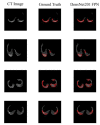Detection and Severity Classification of COVID-19 in CT Images Using Deep Learning
- PMID: 34067937
- PMCID: PMC8155971
- DOI: 10.3390/diagnostics11050893
Detection and Severity Classification of COVID-19 in CT Images Using Deep Learning
Abstract
Detecting COVID-19 at an early stage is essential to reduce the mortality risk of the patients. In this study, a cascaded system is proposed to segment the lung, detect, localize, and quantify COVID-19 infections from computed tomography images. An extensive set of experiments were performed using Encoder-Decoder Convolutional Neural Networks (ED-CNNs), UNet, and Feature Pyramid Network (FPN), with different backbone (encoder) structures using the variants of DenseNet and ResNet. The conducted experiments for lung region segmentation showed a Dice Similarity Coefficient (DSC) of 97.19% and Intersection over Union (IoU) of 95.10% using U-Net model with the DenseNet 161 encoder. Furthermore, the proposed system achieved an elegant performance for COVID-19 infection segmentation with a DSC of 94.13% and IoU of 91.85% using the FPN with DenseNet201 encoder. The proposed system can reliably localize infections of various shapes and sizes, especially small infection regions, which are rarely considered in recent studies. Moreover, the proposed system achieved high COVID-19 detection performance with 99.64% sensitivity and 98.72% specificity. Finally, the system was able to discriminate between different severity levels of COVID-19 infection over a dataset of 1110 subjects with sensitivity values of 98.3%, 71.2%, 77.8%, and 100% for mild, moderate, severe, and critical, respectively.
Keywords: COVID-19; deep learning; lesion segmentation; lung segmentation; severity classification.
Conflict of interest statement
The authors declare no conflict of interest.
Figures









Similar articles
-
A Comparative Study of Decoders for Liver and Tumor Segmentation Using a Self-ONN-Based Cascaded Framework.Diagnostics (Basel). 2024 Dec 8;14(23):2761. doi: 10.3390/diagnostics14232761. Diagnostics (Basel). 2024. PMID: 39682669 Free PMC article.
-
COVID-19 infection localization and severity grading from chest X-ray images.Comput Biol Med. 2021 Dec;139:105002. doi: 10.1016/j.compbiomed.2021.105002. Epub 2021 Oct 30. Comput Biol Med. 2021. PMID: 34749094 Free PMC article.
-
Covid-MANet: Multi-task attention network for explainable diagnosis and severity assessment of COVID-19 from CXR images.Pattern Recognit. 2022 Nov;131:108826. doi: 10.1016/j.patcog.2022.108826. Epub 2022 Jun 6. Pattern Recognit. 2022. PMID: 35698723 Free PMC article.
-
Brain stroke classification and segmentation using encoder-decoder based deep convolutional neural networks.Comput Biol Med. 2022 Oct;149:105941. doi: 10.1016/j.compbiomed.2022.105941. Epub 2022 Aug 28. Comput Biol Med. 2022. PMID: 36055156
-
Automatic Segmentation of Multiple Organs on 3D CT Images by Using Deep Learning Approaches.Adv Exp Med Biol. 2020;1213:135-147. doi: 10.1007/978-3-030-33128-3_9. Adv Exp Med Biol. 2020. PMID: 32030668 Review.
Cited by
-
McS-Net: Multi-class Siamese network for severity of COVID-19 infection classification from lung CT scan slices.Appl Soft Comput. 2022 Dec;131:109683. doi: 10.1016/j.asoc.2022.109683. Epub 2022 Oct 17. Appl Soft Comput. 2022. PMID: 36277300 Free PMC article.
-
Inter-Observer Agreement between Low-Dose and Standard-Dose CT with Soft and Sharp Convolution Kernels in COVID-19 Pneumonia.J Clin Med. 2022 Jan 27;11(3):669. doi: 10.3390/jcm11030669. J Clin Med. 2022. PMID: 35160121 Free PMC article.
-
Review and classification of AI-enabled COVID-19 CT imaging models based on computer vision tasks.Comput Biol Med. 2022 Feb;141:105123. doi: 10.1016/j.compbiomed.2021.105123. Epub 2021 Dec 18. Comput Biol Med. 2022. PMID: 34953356 Free PMC article. Review.
-
Raman and fourier transform infrared spectroscopy techniques for detection of coronavirus (COVID-19): a mini review.Front Chem. 2023 May 18;11:1193030. doi: 10.3389/fchem.2023.1193030. eCollection 2023. Front Chem. 2023. PMID: 37273513 Free PMC article. Review.
-
Automatic COVID-19 and Common-Acquired Pneumonia Diagnosis Using Chest CT Scans.Bioengineering (Basel). 2023 Apr 26;10(5):529. doi: 10.3390/bioengineering10050529. Bioengineering (Basel). 2023. PMID: 37237599 Free PMC article.
References
-
- World Health Organization . Weekly Epidemiological Update on COVID-19, 15 December 2020. World Health Organization; Geneva, Switzerland: 2020. p. 21.
-
- Rubin G.D., Ryerson C.J., Haramati L.B., Sverzellati N., Kanne J.P., Raoof S., Schluger N.W., Volpi A., Yim J.-J., Martin I.B.K., et al. The Role of Chest Imaging in Patient Management during the COVID-19 Pandemic: A Multinational Consensus Statement from the Fleischner Society. Radiology. 2020;296:172–180. doi: 10.1148/radiol.2020201365. - DOI - PMC - PubMed
Grants and funding
LinkOut - more resources
Full Text Sources

